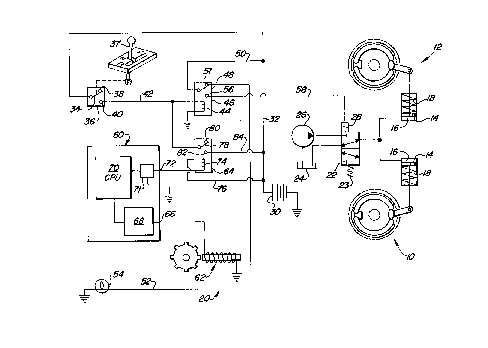Une partie des informations de ce site Web a été fournie par des sources externes. Le gouvernement du Canada n'assume aucune responsabilité concernant la précision, l'actualité ou la fiabilité des informations fournies par les sources externes. Les utilisateurs qui désirent employer cette information devraient consulter directement la source des informations. Le contenu fourni par les sources externes n'est pas assujetti aux exigences sur les langues officielles, la protection des renseignements personnels et l'accessibilité.
L'apparition de différences dans le texte et l'image des Revendications et de l'Abrégé dépend du moment auquel le document est publié. Les textes des Revendications et de l'Abrégé sont affichés :
| (12) Brevet: | (11) CA 2178980 |
|---|---|
| (54) Titre français: | COMMANDE ELECTROHYDRAULIQUE DE FREIN DE STATIONNEMENT SERVANT A EVITER LE SERRAGE DU FREIN LORSQUE LE VEHICULE EST EN MOUVEMENT |
| (54) Titre anglais: | ELECTROHYDRAULIC PARKING BRAKE CONTROL SYSTEM FOR PREVENTING BRAKE ENGAGEMENT WHEN VEHICLE IS IN MOTION |
| Statut: | Périmé et au-delà du délai pour l’annulation |
| (51) Classification internationale des brevets (CIB): |
|
|---|---|
| (72) Inventeurs : |
|
| (73) Titulaires : |
|
| (71) Demandeurs : |
|
| (74) Agent: | BORDEN LADNER GERVAIS LLP |
| (74) Co-agent: | |
| (45) Délivré: | 2000-08-22 |
| (22) Date de dépôt: | 1996-06-14 |
| (41) Mise à la disponibilité du public: | 1997-05-30 |
| Requête d'examen: | 1996-06-14 |
| Licence disponible: | S.O. |
| Cédé au domaine public: | S.O. |
| (25) Langue des documents déposés: | Anglais |
| Traité de coopération en matière de brevets (PCT): | Non |
|---|
| (30) Données de priorité de la demande: | ||||||
|---|---|---|---|---|---|---|
|
Un véhicule possède un système de frein de stationnement comprenant des freins à ressort à détente de pression. Il est prévu un système de commande électrohydraulique destiné à apporter de l'énergie à une valve de frein à commande par solénoïde de manière que de la pression de détente soit fournie aux freins lorsque le levier de commande de transmission est au neutre ou que le tachymètre du véhicule indique une vitesse par rapport au sol autre que zéro.
A vehicle has a parking brake system including spring-applied, pressure- released brakes. An electrohydraulic control system is provided for selectively energizing a solenoid-operated brake control valve so that release pressure is supplied to the brakes when the transmission control lever is not in neutral or when the vehicle tachometer is indicating a ground speed other than zero.
Note : Les revendications sont présentées dans la langue officielle dans laquelle elles ont été soumises.
Note : Les descriptions sont présentées dans la langue officielle dans laquelle elles ont été soumises.

2024-08-01 : Dans le cadre de la transition vers les Brevets de nouvelle génération (BNG), la base de données sur les brevets canadiens (BDBC) contient désormais un Historique d'événement plus détaillé, qui reproduit le Journal des événements de notre nouvelle solution interne.
Veuillez noter que les événements débutant par « Inactive : » se réfèrent à des événements qui ne sont plus utilisés dans notre nouvelle solution interne.
Pour une meilleure compréhension de l'état de la demande ou brevet qui figure sur cette page, la rubrique Mise en garde , et les descriptions de Brevet , Historique d'événement , Taxes périodiques et Historique des paiements devraient être consultées.
| Description | Date |
|---|---|
| Le délai pour l'annulation est expiré | 2016-06-14 |
| Lettre envoyée | 2015-06-15 |
| Inactive : CIB de MCD | 2006-03-12 |
| Accordé par délivrance | 2000-08-22 |
| Inactive : Page couverture publiée | 2000-08-21 |
| Inactive : Taxe finale reçue | 2000-05-03 |
| Préoctroi | 2000-05-03 |
| Un avis d'acceptation est envoyé | 1999-12-17 |
| Un avis d'acceptation est envoyé | 1999-12-17 |
| Lettre envoyée | 1999-12-17 |
| Inactive : Approuvée aux fins d'acceptation (AFA) | 1999-11-15 |
| Modification reçue - modification volontaire | 1999-09-21 |
| Inactive : Dem. de l'examinateur par.30(2) Règles | 1999-03-23 |
| Inactive : Renseign. sur l'état - Complets dès date d'ent. journ. | 1998-09-03 |
| Inactive : Dem. traitée sur TS dès date d'ent. journal | 1998-09-03 |
| Demande publiée (accessible au public) | 1997-05-30 |
| Toutes les exigences pour l'examen - jugée conforme | 1996-06-14 |
| Exigences pour une requête d'examen - jugée conforme | 1996-06-14 |
Il n'y a pas d'historique d'abandonnement
Le dernier paiement a été reçu le 2000-06-13
Avis : Si le paiement en totalité n'a pas été reçu au plus tard à la date indiquée, une taxe supplémentaire peut être imposée, soit une des taxes suivantes :
Les taxes sur les brevets sont ajustées au 1er janvier de chaque année. Les montants ci-dessus sont les montants actuels s'ils sont reçus au plus tard le 31 décembre de l'année en cours.
Veuillez vous référer à la page web des
taxes sur les brevets
de l'OPIC pour voir tous les montants actuels des taxes.
Les titulaires actuels et antérieures au dossier sont affichés en ordre alphabétique.
| Titulaires actuels au dossier |
|---|
| DEERE & COMPANY |
| Titulaires antérieures au dossier |
|---|
| THOMAS DARYL BEBERNES |